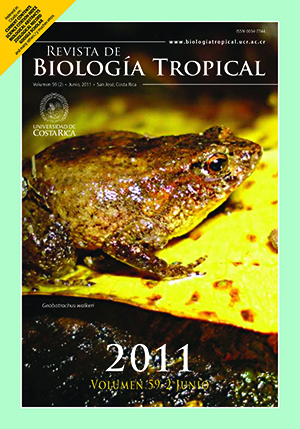Resumen
Diversity is a property of community that can described, characterized, and understood according to the functioning of ecosystems. To study the richness and local abundance and species replacement between habitats around the Zapatosa?s wetland complex (El Cesar Department), I carried out four field trips between November of 2006 and October of 2007. A total of 640 sampling hours/man analyzed five habitat types chasmophyte forest, dry forest, riparian forest, palm-grove and tree-lined savanna; with the exception of the palm-grove sampled at its 75%, the others were sampled up to their 80%. I found 847 reptiles that were distributed in 48 species. The group with the highest number of species was Colubridae with 14, followed by Gekkonidae with five. Five endemic species and eight with some conservation threat grade at a national level are reported. The riparian forest was the richest and most abundant habitat with 34 species and 196 individuals. For each habitat, Colubridae had the highest number of species, followed by the families Polychrotidae, Gekkonidae and Teiidae, in that order. The reptile species composition was not different between the tree-lined savanna and the chasmophyte forest, but differed among the tree-lined savanna and the riparian forest, palm-grove and dry forest habitats. The most important differences in the species composition among almost all the habitats were influenced by the species Anolis tropidogaster and Gonatodes albogularis, and the higher occurrence of Stenocercus erythrogaster in the chasmophyte forest. The species replacement had an average value of 50%; the biggest amounts of shared species were the lizards, while the snake Leptodeira septentrionalis was the only one present in all habitat types. The forest grows-among-rocks showed the biggest complementarity and number of unique species compared to the other habitats. The wetland complex provides two thirds of the reptile's species reported until now for the Caribbean region, and more than 80% of those reported for the El Cesar department. This wetland complex seems to behave as a center for low land species concentration as it hosts a high proportion of species from those places.##plugins.facebook.comentarios##

Esta obra está bajo una licencia internacional Creative Commons Atribución 4.0.
Derechos de autor 2011 Revista de Biología Tropical
Descargas
Los datos de descargas todavía no están disponibles.


